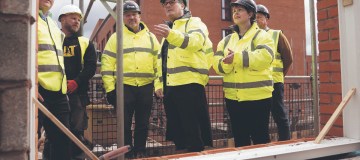The construction sector is crumbling, new data has suggested.
Activity in the UK’s construction industry is contracting at the fastest rate since the coronavirus pandemic in 2020 as high costs and tax hikes bite.
The sector is vital for the Labour government’s plans for a house building boom and improvements in infrastructure, with the private sector expected to help boost the UK’s economic growth.
But S&P Global’s latest purchasing managers’ index (PMI) release suggests construction is suffering from a drop in residential building and civil engineering projects.
The survey of around 150 companies showed another contraction in output as the PMI reading dropped from 48.8 in June to 44.3 last month. Anything over 50 signals expansion, while anything below signals contraction.
Firms said site delays, lower volumes of business orders and weaker consumer confidence had dampened activity.
Respondents also said there was less work being undertaken on public sector projects, which is a worrying sign for Labour given its commitment to build railways, motorways and power plants.
S&P Global said expectations for the next year were below long-term averages, in signs the bleakness surrounding UK economic prospects was weighing on businesses.
Layoffs and recruitment freezes also saw payroll numbers continue to drop for the seventh consecutive month, though the decline in headcount was softer than in previous months.
The data follows an update from the Minerals Product Association (MPA) earlier this week showing that demand for concrete has fallen to its lowest level since 1963, with sales down nearly 12 per cent in the three months to June. The MPA also warned that demand for other building materials such as mortar and sand also fell to “historically low levels.”
The number of new home registrations in London has more than halved as firms shy away from building in the capital.
Just 904 new homes were registered in the second quarter of 2025, down from 2,191 in the second quarter of 2024, according to the National House Building Council (NHBC). London continues to be affected by the new building safety regime for high rise buildings and low building rates from housing associations.
The capital is “by some accounts” the most expensive city in the world to build in, according to the GLA.
Post-Grenfell fire safety regulations have added considerable amounts of red tape, with any building above seven stories now required to have a second staircase.
A community Infrastructure Levy, Section 106 agreements and planning fees, plus still-high interest rates, have pushed many developments past the point of viability.
Story Continues
Pantheon Macroeconomics’ Elliott Jordan-Doak said the small rise in S&P Global’s employment index was a “bright spot” while the moderation of input price pressures also likely to be welcomed by bosses.
“All told, the drop in the construction PMI introduces downside risks for our call of quarter-to-quarter GDP growth in the third quarter of 0.2 per cent,” Jordan-Doak said.
“We still think the fundamentals point to sentiment in the construction sector gradually improving in the coming months.
“The Bank of England will likely cut interest rates in August, reducing borrowing costs for businesses, and the shock from tariff-uncertainty will continue to fade.
“Moreover, the government’s focus on investment spending and planning reforms should also provide support to the construction industry.
“The PMI should recover over the coming months.”

